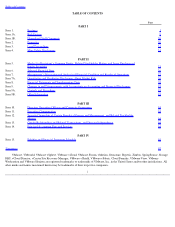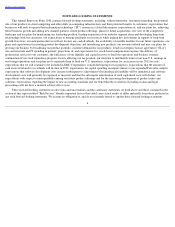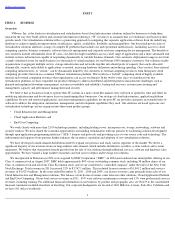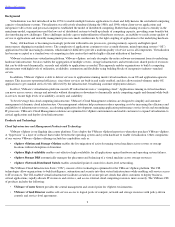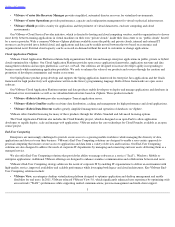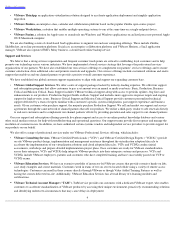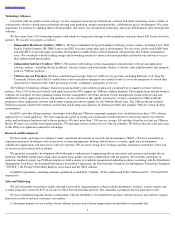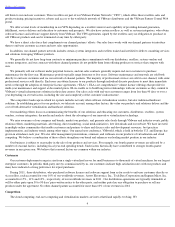VMware 2011 Annual Report Download - page 14
Download and view the complete annual report
Please find page 14 of the 2011 VMware annual report below. You can navigate through the pages in the report by either clicking on the pages listed below, or by using the keyword search tool below to find specific information within the annual report.
Table of Contents
file with, or furnish to, the SEC.
Unless the context requires otherwise, we are referring to VMware, Inc. when we use the terms “VMware,” the “Company,” “we,” “our” or
“us.”
The risk factors that appear below could materially affect our business, financial condition and results of operations. The risks and
uncertainties described below are not the only risks and uncertainties facing us. Our business is also subject to general risks and uncertainties that
affect many other companies.
Risks Related to Our Business
As the market for our computer virtualization products has matured, we have been increasingly developing and marketing products and
services targeted toward the delivery, management and automation of information technology (
“IT”) infrastructure, platforms and services
through cloud-based solutions. If businesses do not find our cloud computing solutions compelling, our revenue growth and operating
margins may decline.
Our products and services are based on computer virtualization and related technologies that have primarily been used for virtualizing on-
premises data centers. As the market for data center virtualization has matured, we have increasingly directed our product development and
marketing toward products and services that enable businesses to utilize virtualization as the infrastructure for cloud-based computing,
management and automation of the delivery of IT resources and end-user computing. We are also investing in the development of products and
services for the emerging platform as a service, or “PaaS,” and software as a service, or “SaaS,” markets. Our success depends on organizations
and customers perceiving technological and operational benefits and cost savings associated with the increasing adoption of virtualization-based
infrastructure and management solutions for cloud computing, application development and end-user computing. Although the use of
virtualization technologies on servers and in on-premises data centers has become broadly accepted for enterprise-level applications, the extent
to which adoption of virtualization for cloud computing and end-user computing remains uncertain. Accordingly, as the market for our data
center virtualization products mature and the scale of our business increases, the rate of growth in our product sales will likely be lower than
those we have experienced in earlier periods and we expect our annual revenue growth rate in 2012 to decline from the growth rate of 32%
experienced in 2011. In addition, to the extent that our newer cloud computing infrastructure management and automation, end-user computing,
PaaS and SaaS solutions are adopted more slowly or less comprehensively than we expect, our revenue growth rates may slow materially or our
revenue may decline substantially.
We expect to face increasing competition that could result in a loss of customers, reduced revenues or decreased operating margins.
The virtualization, cloud computing, and end-user computing markets are inter-related and rapidly evolving. We experienced increased
competition during 2011 and expect it to significantly intensify in the future. For example, Microsoft continues to make incremental
improvements to its virtual infrastructure and virtual management products. Microsoft recently provided details regarding an upcoming major
release of Windows Server, including a more advanced version of its Hyper-V virtualization product, that will continue its push into the
virtualization market. Microsoft also has cloud-based computing offerings. We also face competition from other companies that have announced
a number of new product initiatives, alliances and consolidation efforts. For example, Citrix Systems continues to enhance its end-user and
server virtualization offerings and now has a client hypervisor in the market. IBM, Google and Amazon have existing cloud computing offerings
and announced new cloud computing initiatives. Red Hat has also released commercial versions of Linux that have virtualization capabilities as
part of the Linux kernel (“KVM”) and has also announced plans for cloud computing products. Other companies have also indicated their
intention to expand offerings of virtual management and cloud computing solutions.
We believe that the key competitive factors in the virtualization and cloud computing markets include:
9
ITEM 1A.
RISK FACTORS
•
the level of reliability, security and new functionality of product offerings;
•
the ability to provide comprehensive solutions, including management capabilities;
• the ability to offer products that support multiple hardware platforms, operating systems, applications and application development
frameworks;
• the ability to deliver an intuitive end-user experience for accessing data, applications and services from a wide variety of end-user
devices;
•
the proven track record of formulating and delivering a roadmap of virtualization and cloud computing capabilities;
•
pricing of products, individually and in bundles;


